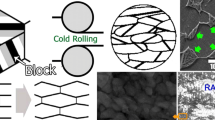Abstract
The industries of developed countries widely use alloy steel-copper pseudoalloys. In copper-infiltrated steels the strength, ductility, and wear resistance increase due to the creation of a structure with a greater proportion of metastable austenite. Such a structure can be obtained by a substantiated choice of the composition, concentration inhomogeneity, and appropriate heat-treatment regime of the material. The present paper is devoted to the decomposition of supercooled austenite in chromium-nickel steel-copper pseudoalloys with an optimum distribution of the alloying additives.
Similar content being viewed by others
References
I. Le May and L. M.-D. Shetky,Copper Ferrous Metals [Russian translation], Metallurgiya, Moscow (1988).
W. R. Kelley and H. Zhou, “The influence of heat treatment and copper infiltration on the mechanical properties of powdered metal parts,” in:European Conf. on Advances in Structural PM Component Production, Munich, Germany (15–17 October; 1997) (1997), pp. 183–190.
D. F. Berry, M. Svilar, and E. Klar, “High impact and tensile strength, PM boron steel by copper infiltration,” in:Int. Conf. Powder Met. London, (2–6 July, 1990): PM'90, Vol. 2, London (1990), pp. 255–258.
N. F. Vyaznikov and S. S. Ermakov,Powder Steels and Parts [in Russian], Mashinostroenie, Moscow (1990).
V. N. Antsiferov, V. B. Akimenko, and L. M. Grevnov,Powder Alloy Steels [in Russian], Metallurgiya, Moscow (1991).
V. N. Antsiferov, L. M. Grevnov, and O. M. Perel'man, “Isothermal decomposition of supercooled austenite in powder steels alloyed with chromium and molybdenum,”Metalloved. Term. Obrab. Met., No. 8, 28–33 (1992).
Yu. G. Gurevich and V. I. Rakhmanov,Heat Treatment of Powder Steels [in Russian], Metallurgiya, Moscow (1985).
V. N. Antsiferov, A. A. Shatsov, and M. G. Latypov, “Isothermal decomposition of austenite of concentration-inhomogeneous nickel alloys,”Metalloved. Term. Obrab. Met., No. 5, 20–24 (1998).
V. N. Antsiferov, S. N. Bobrova, O. M. Perel'man, and A. A. Shatsov, “Isothermal decomposition of austenite of powder nickel-molybdenum steel,”Metalloved. Term. Obrab. Met., No. 8, 18–20 (1993).
Yu. G. Gurevich, A. G. Ivashko, V. I. Rakhmanov, et al., “The kinetics of decomposition of supercooled austenite and mechanical properties of steel SP70D3 before and after copper impregnation,”Poroshk. Metal., No. 9, 62–66 (1992).
A. G. Ivashko, V. I. Rakhmanov, I. F. Pan'shin, and A. I. Mikurov, “Effect of porosity on the kinetics of decomposition of supercooled austenite and mechanical properties of steel SP100D3,” in:Thermodynamics and Kinetics of Metallurgical Processes [in Russian], Kurganskii Mashiniostr. Inst., Kurgan (1995), pp. 39–43.
V. N. Antsiferov, N. N. Maslennikov, A. A. Shatsov, and T. V. Smyshlyaeva, “Powder steel with a structure of metastable austenite,”Poroshk. Metal., No. 3/4, 42–47 (1994).
V. N. Antsiferov, A. A. Shatsov, and T. V. Smyshlyaeva, “Wear and fatigue resistance of metastable steel-copper pseudo-alloys,”Metalloved. Term. Obrab. Met., No. 12, 15–20 (1997).
V. N. Antsiferov, T. V. Smyshlyaeva, and A. A. Shatsov, “Surface transformation of steel-copper pseudoalloys in contact with an abrasive,”Fiz. Khim. Obrab. Mater., No. 2, 79–88 (1997).
S. L. Akhnazarova and V. V. Kafarov,Optimization of Experiment in Chemistry and Chemical Technology [in Russian], Vysshaya Shkola, Moscow (1978).
M. Hansen and K. Anderco,Structures of Binary Alloys [Russian translation], Metallurgizdat, Moscow (1962).
V. N. Antsiferov, A. A. Shatsov, and M. G. Latypov, “Special features of the trip-effect in powder concentration-inhomogeneous steels with a low nickel content,”Metalloved. Term. Obrab. Met., No. 8, 15–19 (1997).
L. S. Malinov, “Use of the principle of fabrication of metastable austenite and control of its amount and stability in the development of sparingly alloyed alloys and hardening treatment techniques,”Metalloved. Term. Obrab. Met., No. 2, 35–39 (1996).
A. A. Shatsov and T. V. Smyshlyaeva, “Copper infiltration carbide steels with structurally unstable matrix,”Trenie Iznos,19(1), 109–115 (1998).
Author information
Authors and Affiliations
Additional information
Translated from Metallovedenie i Termicheskaya Obrabotka Metallov, No. 1, pp. 11–14, January, 2000.
Rights and permissions
About this article
Cite this article
Smyshlyaeva, T.V., Shatsov, A.A. Isothermal decomposition of supercooled austenite in chromium-nickel steel-copper pseudoalloys. Met Sci Heat Treat 42, 13–16 (2000). https://doi.org/10.1007/BF02471349
Issue Date:
DOI: https://doi.org/10.1007/BF02471349




